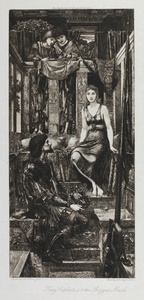| Method | Etching |
| Artist | Luke Thompson Taylor after Sir Edward Coley Burne-Jones |
| Published | The Art Journal 1908, London Virtue & Co. |
| Dimensions | Image 262 x 118 mm, Plate 295 x 146 mm, Sheet 432 x 270 mm |
| Notes |
The story of Cophetua concerns an ancient African king who disdained women, and was supposedly immune to affection. Upon glancing at a beggar maid named Penelophon, however, he vowed to make her his Queen. Love transcends class and reason. Burne-Jones drew upon two sources for the subject. Richard Johnson's ballad 'A Song of a Beggar and a King', 1612, which was reprinted by the Percy Society in 1842, and Tennyson's poem 'The Beggar Maid.' The elaborate composition is thought to have been inspired by Carlo Crivelli's 'Annunciation with Saint Emidus,' which entered the London National Gallery in 1864. In fact, the peacock which is so focal in Crivelli's altarpiece, is replicated in the balustrade behind the beggar maid's head. Luke Thompson Taylor (1873 - 1916) was a British etcher who was an important exponent of the medium during its revival in the latter half of the nineteenth-century. Known to have produced works after Burne-Jones and Madox Brown. Sir Edward Coley Burne-Jones, 1st Bt (1833-1898) was a painter and designer closely associated with the later phase of the Pre-Raphaelite movement. Burne-Jones met William Morris as an undergraduate of Exeter College, Oxford, whilst studying for a degree in theology. The pair went on to work very closely together on numerous decorative arts projects including stained glass windows, tapestries, and illustrations. Originally intending to become a church minister, Burne-Jones never finished his degree, choosing instead to pursue an artistic career under the influence of Dante Gabriel Rossetti. Rossetti heavily inspired his early work, but by the 1860's his idiosyncratic style was beginning to develop. His mature work, however different in total effect, is rich in conscious echoes of Botticelli, Mantegna and other Italian masters of the Quattrocento. Thusly, Burne Jones' later paintings of classical and medieval subjects are some of the most iconic of the Pre-Raphaelite movement. He was at the height of his popularity during the 1880's, though his reputation began to decline with the onset of the Impressionists. He was created a baronet in 1894, when he formally hyphenated his name. |
| Framing | mounted |
| Price | £185.00 |
| Stock ID | 45759 |

